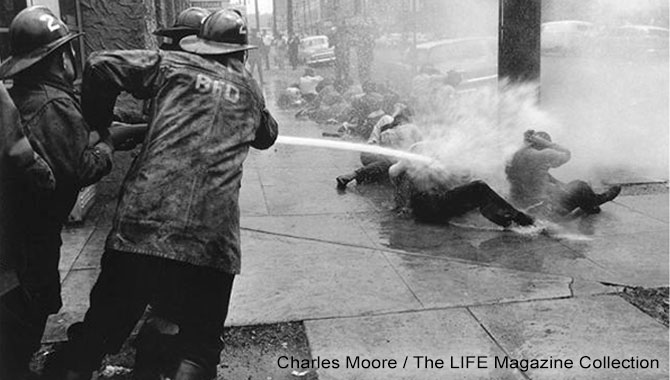Just as you, Father, are in me, and I in you, so they might be one heart and mind with us. ~John 17:21, (The Message)
Stand where we are supposed to stand and let God do the rest. ~Father Ron Rolheiser
Several years ago in a sermon, I showed a picture of firemen in Birmingham, Alabama, mowing down peaceful demonstrators with water from fire hoses. The demonstrators were marching for their dignity, their humanity, and their equality (civil rights) for African Americans. The firemen cut down demonstrators and punished them with the sheer force of the water shooting from the fire hoses.
I asked, “Where is Christ in this picture? Would Christ be on one side of the fire hoses or the other?”
After the worship service, a man came up to me and asked, “Craig, you did not tell us which side of the hose Christ was on. Would Jesus keep law and order and knock people down with the force of the water or would he be with the protestors who were breaking the law?”
I said, “Are you serious?” He replied, “Yes, how do we know where God would stand?”
Where does Jesus stand? As people of faith, are we standing where we are supposed to be standing? Are we being faithful to the way of grace, the way of Christ? Are we “rooted and grounded in love” (Ephesians 3:17)? When we stand, do we “clothe ourselves in compassion, kindness, humility, meekness, patience, and above all else love” (Colossians 3:12, 14)?
Where do we stand on border security? Immigration? Where do we stand on Covid-19 vaccines and masks? Where do we stand on race and ethnic inequality? Where do we stand on health care? Capital punishment? Prison reform? Economic inequality?
The issues are complex.
What do we do when our boss is cooking the books? How do we respond when our child lies to us? How do we handle our own flaws? Our infidelity?
Father Greg Boyle writes, “The strategy of Jesus is not centered in taking the right stand on issues, but rather in standing in the right place—with the outcast and those relegated to the margins.” As Boyle says, “Jesus didn’t seek the rights of lepers. He touched the leper. He didn’t champion the cause of the outcast. He was the outcast. He didn’t fight for improved conditions for the prisoner. He simply said, ‘I was in prison.’”
Jesus chose oneness or unity with others. “May you be one as the Father and I are one” (see John 17:21). “Jesus was not a man for others. He was one with others,” says Boyle. Jesus loved everyone and he stood in compassion, empathy, and unity with those on the margins.
My friend Sia is a United Methodist Minister in the San Francisco Bay area. Many years ago, he told me his teenage daughter became pregnant out of wedlock. His parishioners were outraged. “You need to denounce her and her boyfriend’s irresponsible behavior. If you don’t, our youth will think it’s OK to do anything. We will leave the church if you don’t address this!” Sia stewed and stewed.
One Sunday Sia waited for everyone to arrive in church. When all were seated, Sia stepped out of a back room with his very pregnant daughter. He stood tall, held his daughter’s arm in his, walked her down the aisle, and gave her a kiss on the cheek as he seated her in the front row with his wife. He did not say a word and neither did his parishioners who later hosted a baby shower for his daughter.
Sia did not take a stand on the issues; instead, he and his wife chose kinship and oneness with their daughter. They stood with her.
May we stand in our Creator’s compassion, kindness, humility, and love.
May we stand with the outcasts and those on the margins.
May we stand in the right place and let God do the rest.
Blessings, peace, and all good,
Craig

